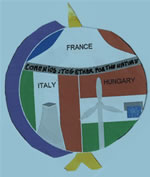Hydropower:
Hydroelectric power plant:
An establishment that transforms the energy of rivers, seas, watercourses into electricity. The abstraction ’hydroelectric station’ or ‘hydroelectric power plant’ covers all the objects and facilities that are required for this transformation.
The story of water:
Water has existed on Earth for about 4 billion years. Earth has so special place in the Solar System that you can find all the three different existences of water on it (solid, liquid and gas). It is estimated that life evolved approximately 3,5 billion years ago. It could not be possible without water.
Water is our oldest resource. Water wheel was used for watering and supplying drinking water in China, Egypt and Mesopotamia. Watermills have been used since roman era. They were deployed onto ships as well as to the land in order to grind grains. Water wheels also were used for heating iron or blasting air at forges and frittering lumber at sawmills. They even were used to dehydrate mine-shafts. Later steam-engines and then water turbines have been started to be used. Strong current of water has been better for the latter and the flow’s kinetic energy has been transformed into electricity when generators were developed.
It is estimated that Earth is covered by 1,4 billion km3 water. It is hard to believe but it is true that this stupendous body of water is involved in a 9 days long circulation. Circulating water is facilitated by 23 percent of Sun’s energy that is radiated onto Earth. 99 percent of this energy is used for the process of evaporation-precipitation that is idle capacity. The remaining 1% is not else than the potential and kinetic energy of water. This is what we try to use as hydropower.
Water destroys and constructs at the same time. Rivers delivers almost 3000 millions of tons of river drift. That is the reason that the mainland’s height has been decreased by only 1 meter in every 100 thousand years. On the other hand rivers also bank up lakes or build deltas in seas and oceans.
The evolution of hydropower:
Usage of hydropower was restricted in the beginning since it was possible to use only on the spot. However, utilization of this energy has boomed by developing the first water turbine. The turbine transformed 80% of the energy of water into mechanical energy. Engineers started thinking about generating electricity by hydropower. Water turbine has spread like wildfire. The developing technology made it possible to create all kinds of turbines that have been more effective and more productive.
What is the turbine?
A turbine is a rotary engine that transforms kinetic energy from a fluid flow into mechanical energy by rotors.
Modern turbines:
Reaction turbines: Francis turbine, Kaplan turbine, Bulb turbine, Water turbine, Pump turbine
Impulse turbines: Pelton turbine, Bánki turbine
Utilization of hydropower:
Before you start designing a hydroelectric station, a decision needs to be made about the desired performance of the power plant that matches to the characteristic of the river. Strength of current of the river, water-level and fluctuating runoff all has an influence on the type of the hydroelectric power plant. In the case of modern power plants it is also important whether the river is frozen in any period of the year.
Italy, Switzerland, Sweden, Norway and Finland are the leading hydropower users of the world. During the last few decades powerful hydroelectric stations also have been built in Russia, Germany, the USA, South-America, Brazil and Africa. The most potential hydropower resource is available in Africa where conditions are the best in Congo.
Environmental impact of hydroelectric power plants:
Unfortunately the longer a hydroelectric power plant is working the more the ecological damage. If a power plant is designed and built improperly, fishes could not spawn that exposes rare species to danger. Plants could overrun the surface of the water thus blocking the flow of water, sediment and available nutrients. Peasants’ estates along the riverside could be weak in mould. Sediment delivered by rivers is nutrition for creatures living in water and they might be forced to move away their usual place of reproduction for lack of food.
Utilization in Hungary:
The rate of flow is extremely slow on the rivers of Hungary. Actually it is one of the lowest all over the world. For example the difference of the water-level on river Tisza is only 2-3 cm within 1 km. Under these circumstances there is not too much chance to utilize our rivers. Several hydroelectric stations were designed after the first world war but they have been never built. Using hydropower on river Tisza is limited enough. Percentage distribution of utilization of hydropower on rivers in Hungary: Danube 72%, Tisza 10%, Dráva 9%, Rába and Hernád 5%, others 4%.
Main hydroelectric power plants in Hungary: Ikervár, Körmend, Csörötnek, Alsószölnök, Kesznyéten, Felsődobsza, Gibárt. These power plants need to be refurbished since the applied technology is out of date and their efficiency could be improved by renovation


